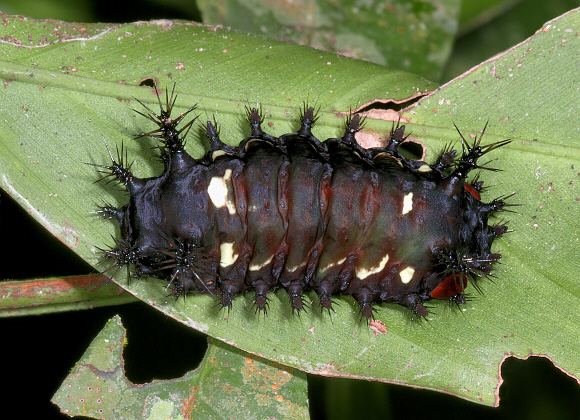 Acharia nesea ( or closely related species ), Rio Madre de Dios, Peru – Adrian Hoskins
Acharia nesea ( or closely related species ), Rio Madre de Dios, Peru – Adrian Hoskins
Introduction
The superfamily Zygaenoidea is represented in the neotropical region by the families Limacodidae, Megalopygidae, Dalceridae, Epipyropidae, and Zygaenidae.
The Limacodidae is one of the most interesting of the Lepidopteran families. The adult moths have long abdomens and huge thick finger-like legs. When freshly emerged, they have a glossy satin-like appearance and often exhibit rich purplish-red tones, but these tend to quickly fade to a dull brown.
The number of species in the genus Acharia is undetermined because it is regarded as synonymous with Sibine by some workers. Sibine (sensu lato) comprises about 51 species, distributed from the southern states of the USA to Brazil and Peru.
Acharia nesea is found from Mexico to Peru.
Habitats
This species inhabits rainforest at elevations between about 200-800m.
Lifecycle
Limacodid larvae are among the most extraordinary insects on the planet. Phobetron, for example, are bright orange and have extremely long curved lateral protruberances, each of which creates the illusion that it is an individual caterpillar rather than an appendage of a single one. Sibine larvae are typically bright green with a large purplish ‘saddle’ ringed with white. In common with Archaria, they are armed with conical fleshy horns that bear tussocks of stinging hairs which can inflict severe pain.
In Archaria nesea, the white spots usually form a contiguous line which runs along the side of the larva and loops over its back to produce a white-edged ‘saddle’. It is therefore uncertain whether the illustrated larva is a form of nesea, or a different species. The prolegs of Acharia and other Limacodids are reduced to form small suckers.
Being unable to walk normally, they lay down a cushion of lubricant on which they glide in a slug-like manner. The pupa is formed within a hard cocoon which has a circular escape hatch formed along a line of weakness. Prior to emergence, the pupa forces the hatch open to allow the moth to escape.
Adult
The adult moths have massive abdomens and huge thick finger-like legs. Freshly emerged adults have a shiny satin-like appearance and often exhibit rich purplish-red tones, but these tend to quickly fade to a dull brown.
